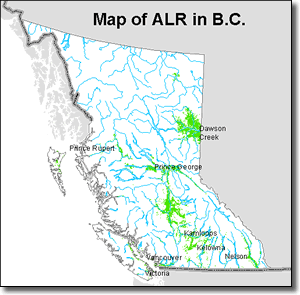Agriculture will always play an important role in the social and economic well-being of British Columbia. B.C. farmers currently meet about 50 percent of our food needs and the importance on producing local, healthy food for our growing population is increasing. The agriculture industry will need to continue to innovate and adapt, become more water efficient, and bring more land into production.
This page will help you find out what the B.C. government is doing to help farmers access more water and encourage water efficiency and best management practices on B.C. farms and ranches.
In some areas of the province, the agricultural sector accounts for up to 70% of the surface and groundwater consumed. The rate of consumption is the greatest during the hot, dry summer months when water supplies are most vulnerable. Technologic advances in irrigation systems and practices mean water use can be significantly more efficient.
Becoming water efficient has many benefits for the industry and the environment, including reduced energy consumption and pumping costs, and reduced impacts on streams and groundwater aquifers.
The majority of farming activities in British Columbia take place within the
Agricultural Land Reserve (ALR).
Helping farmers manage water demand
The B.C. government has developed an Irrigation Scheduling Calculator for landscape and agricultural irrigators to improve irrigation management by using real-time climate data. Irrigators are now able to enter their own specific crop, soil and irrigation system information, and the calculator determines the irrigation requirements based on current local weather conditions and forecasts. You can access the calculator by clicking on the calculator tab on www.irrigationbc.com.
The Environmental Farm Plan program, delivered through the British Columbia Agriculture Council, also includes detailed assistance for irrigators. The Irrigation Assessment Guide assists farmers and ranchers improve their water management and implement beneficial irrigation management practices through examples and worksheets for self-evaluation.

What can you do?
- Get helpful information on agricultural best practices and water management from waterbucket and farmwest.com.
- Use the Irrigation Scheduling Calculator to help plan your irrigation schedule.
- You can establish a climate station on your own land and link the local information to share with others.
- The Water Balance Model promotes a watershed-based approach that manages the natural and built environments as integrated components of the same watershed.
Did you know?
- In the Okanagan Similkameen area there is a total of 176,000 hectares of land within the ALR but less than one third is presently irrigated.
- Given today’s technology, we need over half a hectare of farmland (or 6 city blocks) to produce a healthy diet for one person for one year.
- Crops that are irrigated use 4% of the productive land but account for 40% of farm income.

The ALR is a provincial land use zone, established in 1973 to preserve farmland and recognize agriculture as the priority use. It includes private and public lands that may be farmed, forested or vacant land. Nearly a third of the ALR is in the Peace River and Northern Rockies Regional Districts. Only 2.6 million hectares of the 4.7 million hectares included in the ALR is currently being farmed – about half of this land is considered to have high capability to produce agricultural products. The balance of the ALR lands in B.C. has greater limitations due to soil type, location, climate, or restricted access to water. An irrigation water supply is necessary for approximately two thirds of the total ALR area to actively cultivate crops on the land.



 The ALR is a provincial land use zone, established in 1973 to preserve farmland and recognize agriculture as the priority use. It includes private and public lands that may be farmed, forested or vacant land. Nearly a third of the ALR is in the Peace River and Northern Rockies Regional Districts. Only 2.6 million hectares of the 4.7 million hectares included in the ALR is currently being farmed – about half of this land is considered to have high capability to produce agricultural products. The balance of the ALR lands in B.C. has greater limitations due to soil type, location, climate, or restricted access to water. An irrigation water supply is necessary for approximately two thirds of the total ALR area to actively cultivate crops on the land.
The ALR is a provincial land use zone, established in 1973 to preserve farmland and recognize agriculture as the priority use. It includes private and public lands that may be farmed, forested or vacant land. Nearly a third of the ALR is in the Peace River and Northern Rockies Regional Districts. Only 2.6 million hectares of the 4.7 million hectares included in the ALR is currently being farmed – about half of this land is considered to have high capability to produce agricultural products. The balance of the ALR lands in B.C. has greater limitations due to soil type, location, climate, or restricted access to water. An irrigation water supply is necessary for approximately two thirds of the total ALR area to actively cultivate crops on the land.
